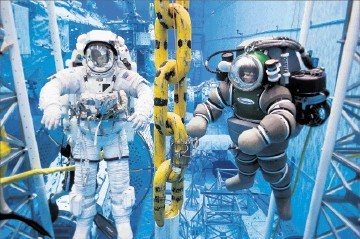
NASA is famous for the US programme to send man to the moon. However, its interests cover a multitude of areas and oil workers are now able to use one of its world-class facilities in Houston for offshore survival training. Ian Forsyth finds out more
The Johnston Space Center in Houston is home to the world’s largest indoor pool.
It is more than 200ft long, 40ft deep and holds 6.2million gallons of water.
The pool – known as the Neutral Buoyancy Laboratory – can simulate the weightless environment of space and allows astronauts to train for space walks on full-size replicas of space station modules.
But the facility is no longer just for astronauts.
The pool time required for their training has dropped due to the end of the space shuttle programme and completion of the international space station.
Aberdeen-based Petrofac Training Services (PTS) has now stepped in to use spare time in the pool for oil worker survival training.
A multi-year partnership with Raytheon Technical Services – NASA’s contractor for operations at the facility – was announced at the end of last year.
Huge demand for offshore survival training in the US means that PTS will take around 2,000 offshore workers to the NASA facility in 2012 alone.
The partnership will deliver Hi-Con survival training and also expand into the delivery of emergency response and crisis management training at the site.
PTS, part of Petrofac group, currently trains around 60,000 offshore workers worldwide every year.
Tony Littler, regional director for the Americas with PTS, said: “Current offshore survival training centres in the US cannot keep pace with demand; particularly in the Gulf of Mexico where employment is projected to increase by 77% in the next three years.
“The Neutral Buoyancy Laboratory is the most sophisticated and technologically-advanced underwater training centre in the world due to the equipment, the size and scale of the pool, the history and the experience of the teams who manage and facilitate the training.
“In addition, the technology and monitoring equipment incorporated in the pool provides a unique training environment from which to learn and refine critical aspects of water survival.
“The cultures of Raytheon and NASA are similar to ours and the location in a global energy hub means we are able to leverage lessons from the aerospace industry more readily than if we attempted this elsewhere.”
The type of training the oil workers get in the Neutral Buoyancy Laboratory includes helicopter safety and escape training.
Tracy Cox, director of performance consulting at Raytheon Professional Services, said there were several reasons for Raytheon becoming involved in the PTS tie-up.
He said: “The first factor was the opportunity to assist our customer, NASA, in finding commercial applications for the Neutral Buoyancy Laboratory.
“When we considered its Houston location, the reputation of NASA in the Gulf of Mexico region and the fact that the Gulf of Mexico is a major global hub of the oil and gas industry, it made a lot of sense.
“Secondly, we believe that many companies within the oil and gas industry, both upstream and downstream, are facing challenges today that create significant opportunities to streamline, make more efficient, make more effective and match the delivery methods of training to better match the objectives, thus saving money and increasing the speed to proficiency.
“We believe we can help significantly, based on our global track record in that area as a learning integrator.
“Thirdly, the oil and gas industry continues to grow and with that growth will come even greater challenges associated with inexperienced employees who must excel in a more complex work environment with ever-increasing speed. This will require a transformation of the learning system from end-to-end and will require looking outside the industry for best practices and lessons learned.
“Lastly, but not necessarily of least importance, is when we looked at multiple market verticals, oil and gas stood out as an industry that operates daily in a high risk, highly complex, highly regulated, “failure is not an option” environment where safety is even more important than it has ever been and workforce security is paramount.
“We believe this is a perfect match for our cultures. It’s what we are built on, where we excel and where we have demonstrated the greatest successes.”